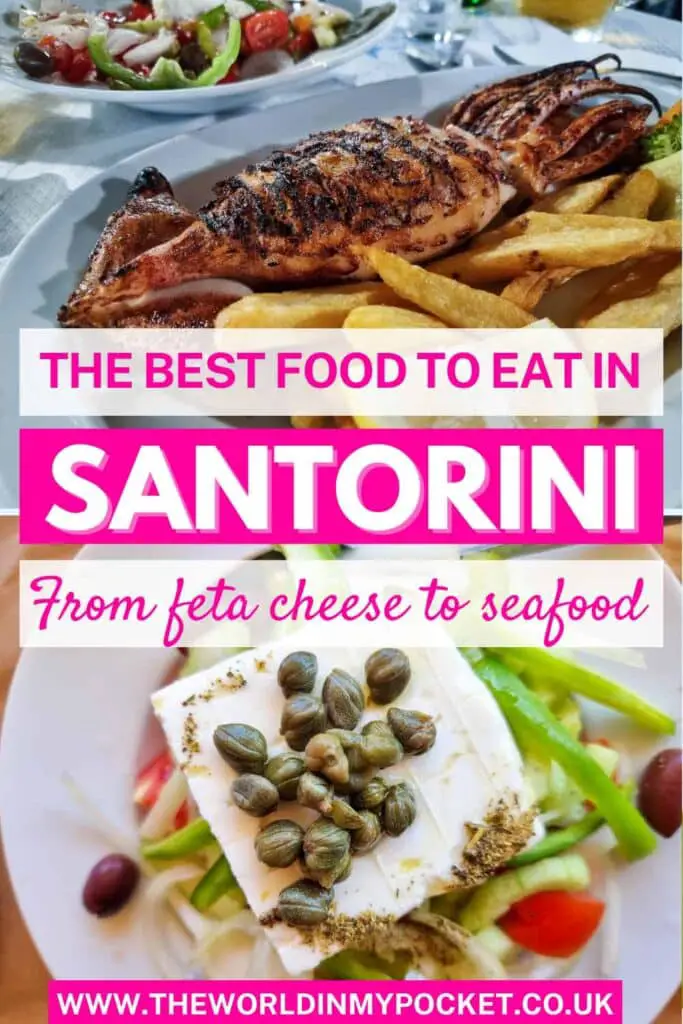If you are wondering what to eat in Santorini, I’ve got you!
In this article I want to share with you my Santorini food guide and tell you which dishes are unmissable. No matter what you decide to go for, I can guarantee that the food in Santorini will leave you extremely satisfied. Most of the ingredients used to cook the local dishes in Santorini are grown on the island, and the fish always comes from the Aegean sea.
I have to admit that one of the reasons I was very excited to travel to Santorini was to try all the local food. Whilst I often buy feta cheese at home, I really wanted to try it in its home country, together with all the other fantastic Greek dishes in Santorini. I boarded the plane to Greece with a list of foods to eat in Santorini and spent my holiday ticking off the most delicious delicacies: delicate fried feta cheese with honey, juicy tomato fritters, fresh grilled calamari and prawns, refreshing tzatziki, and the list goes on…..
About the Restaurants in Santorini

You will find plenty of authentic restaurants in Santorini – but you will also find a lot of rip offs. As a rule of thumb, always check the menu and the prices before you agree to sit down at a table. Never order something that is not on the menu. Beware on the fish prices – some restaurants price them per 100grams instead of for the entire dish.
Check your bill when you get it. That “would you like some tzatziki or some pita bread” alongside will cost you 10 euros extra! However, I did encounter tavernas where they brought extra dips as well as a small carafe of Raki on the house, after we sat down. They did tell us though that they were on the house, compliments of the chef.
Expect to pay more at a restaurant with a view, especially in Oia or Fira.
Eating Out in Santorini – The Prices

The closer you are to Oia, the higher the prices of eating out in Santorini will be. Being based in the south of the island, I made it a point to wait until I got back from exploring Santorini, before having dinner. I found some lovely restaurants and tavernas along the seafront of Perivolos Beach, where my hotel was.
On my first evening in Santorini I was lucky enough to be part of a Greek night at a traditional taverna. A band started to play traditional Greek music and the staff just joined in. When we were brought extra plates we knew we were in for an amazing time! Just 15 minutes later, all the guests in the taverna were dancing and smashing plates on the floor, enjoying the Greek atmosphere. It was fantastic!
In this area, the price of a two course meal for two, plus drinks, was around 40-50 euros, depending on the restaurant. In Thirasia island, the price of lunch for two, with drinks, was 36 euros. In Fira, we paid 50 euros just for a quite small lunch with drinks – the food was very good and the establishment lovely, but you do pay extra for the area.
The Cuisine in Santorini

Santorini is a volcanic island with a very rough and irregular terrain. The weather in Santorini is very harsh as well, with scorching summers and very windy, cold winters. There are no natural sources of water in Santorini either. Growing fruits and vegetables on the island is quite tricky. However, not impossible, and due to the rich minerals and nutrients of the volcanic soil, the agricultural products are always of top quality with an enhanced flavour.
Some of the local produce of Santorini include cherry tomatoes, grapes, yellow split peas, capers, and white aubergines.
Cheese
Almost every island in Greece has its own traditional cheese and Santorini is no exception. The Chlorotyri cheese, also known as Chloro, is a fresh cheese made from goat’s milk by the Santorini ladies on the island, in very limited quantities.
You can’t really buy Chloro cheese at the supermarket so if you see the Santorini salad on a menu and want to try this cheese, order it. The Santorini salad is traditionally made with Chloro cheese, which only some taverns can procure directly from the producers.
The texture of the Cholo cheese is much crumblier than feta, harder, and it tastes saltier.
Santorini Tomatoes
My first encounter with the Santorini tomatoes was from a bus, travelling to Pyrgos. All I could see on the rough mountain side of the road were what looked to me like dead plants filled with deep red, ready to be picked, tomatoes. I asked myself how those plants could possibly survive out in the open, with all that sun and no water. Well, they can!
The Santorini tomatoes are sweet and have a unique flavour, quite hard to describe. You will have to travel to Santorini to taste them yourself.
White Eggplant
The white eggplants that grow in Santorini are special because they have no bitterness. Instead, the flesh of the aubergine is sweet and juicy, making the traditional Greek moussaka taste so much better. Many people don’t like aubergines because of their bitterness. If you are one of them, give the Santorini white aubergines a try!
What to Eat in Santorini
Now that I’ve told you a little about the logistics of eating in Santorini, let’s get to it. These are the dishes that I enjoyed most during my trip to Santorini. I hope you will try at least some of them, and please enter your favourite in the comments section. I’d love to know!
Fava

When I asked around what was the traditional dish of Santorini, everyone said the same thing: fava!
Fava is a hearty, creamy, delicious dip, made from yellow split peas grown in the volcanic soil of the island. It is seasoned with garlic, onions, lemons juice, herbs, and extra virgin olive oil. It is served on its own, drizzled with more extra virgin olive oil and capers, alongside pita bread, or topped with seafood or slow cooked lamb.
I tasted the fava as a complimentary dip, at a seafront taverna in Perivolos. It tasted fantastic, so creamy and delicate. Instead of the capers, it was served with a pickled chili pepper, which gave it a bit of a kick.
Tzatziki

I’m still dreaming of the fresh and delicious tzatziki I had in Santorini. Tzatziki is a dip I make often in my kitchen as I think it’s a great side for hearty dishes. And before I travelled to Greece, I thought that my tzatziki was pretty good. Now, after tasting it at different restaurants in Santorini, I think mine is pretty mediocre.
The tzatziki in Santorini is extremely creamy and light, with perfectly balanced flavours of cucumber, garlic and olive oil. I’m not exaggerating when I say that for almost every meal I ordered in Santorini, I added tzatziki on the side as well.
Feta Cheese Dip – Tirokateri

Another fantastic dip that you can find in Santorini is the tirokateri, a spicy feta cheese spread. The cheese is blended together with chili peppers until it gets a creamy consistency. Then, milk is added to cut down from the spiciness of the chillies.
The dip is delicious and works so well on a mezze platter, or as a spread for pita bread. I highly recommend ordering it if you see it on the menu – I didn’t very often.
Pita Bread

I don’t think I need to introduce the best bread in Greece – the pita. In the local tavernas in Santorini, it is usually just brought to the table, often on the house. Sometimes it is served simple, otherwise it’s filled with melted butter and garlic. It’s never missing from a mezze platter.
Pita bread is a light, round flatbread made with wheat flour and yeast. It is very flexible, perfect for wrapping around the gyro ingredients.
Tomato Fritters – Tomatokeftedes

The tomato fritters, or tomatokeftedes, their Greek name, is another traditional dish in Santorini. Often referred to as tomato balls, they’re always on the menus of the local tavernas in Santorini. The tomatokeftedes are made using the Santorini cherry tomatoes, once they reach the over ripe stage and become very sweet.
The other ingredients going into the mixture of the tomato fritters are red onions, sweet peppers, fresh basil, dried oregano, feta cheese, as well as flour to blend it all together. The result is delicious, sweet fritters, often served with a yogurt dip. They are perfect as an appetiser – but to share, as a normal portion comes with 4-5 of them, and they are big!
Fried Feta Cheese With Honey

I tried the fried feta cheese with honey for lunch, on my last day in Santorini. I couldn’t help myself, and just had to order more feta cheese. The dish arrived at the table in a small pan, covered with dripping honey.
The flavour was incredible! The outside of the cheese was very crunchy whilst the middle, incredibly soft and creamy. The entire cheese was covered in a thin but flaky layer of phyllo pastry. The combination of the saltiness of the cheese with the sweetness of the honey, together with the texture of the entire dish, was a proper delight for my taste buds.
Greek Salad

The Greek salad is so simple, yet so full of flavour. The ingredients are roughly chopped not even mixed, and that is because the freshness speaks for itself: meaty tomatoes, sliced cucumbers, red onions and red peppers, olives, and an entire block of feta cheese on top. The cheese is seasoned with a generous amount of dried oregano, capers, and plenty of olive oil.
I ordered a Greek salad as a side with every lunch and dinner in Greece, that’s how much I loved it.
Santorini Salad

The Santorini salad is very similar to the Greek salad. The difference is that instead of feta cheese, the local Chlorotyri cheese is used, as well as the extra ingredient of dried barley or wheat rusks. As much as possible, the ingredients in the Santorini salad are grown on the island. As the Chlorotyri cheese is produced in limited quantities, the Santorini salad usually costs 2-3 euros more than the Greek salad.
Baked Feta Cheese

The baked feta cheese is another Greek delicacy that you can find in Santorini. The entire block of feta cheese is seasoned with dried oregano, onions, cherry tomatoes, and spicy peppers, and baked in the oven until all the aromas infuse.
The result is a creamy, spicy cheese, which is best savoured scooped out of the aluminium foil on strips of pita bread.
Saganaki

Saganaki is a very simple but full of flavour Santorini dish. It is usually served as an appetizer, and makes a great accompaniment to a mezze platter. Saganaki is a way of preparing hard cheese such as graviera, kefalograviera or kefalotyri, by pan frying it in a small pan until it has a golden crust. The name of the dish comes from the pan it is fried in, which is called “sagani”.
The cheese used to make saganaki is hard and has a mild, nutty flavour. Saganaki is served straight from the pan, and what makes it special is the gooey, very tasty interior. It is served with wedges of lemon which sharpen the taste of the dish. You have to eat it fast, before the middle starts to go hard again. But that is not a problem, as saganaki is too good for leftovers.
Dolmades

As an Eastern European, I am familiar with dolma and how many variations of this versatile dish there are around the region. Whilst in my home country we call them “sarmale” and wrap a mixture of rice and meat in pickled cabbage leaves, in Greece they are called “dolmades” and are wrapped in vine leaves. The Greek dolmades are vegetarian, with a filling of herby rice seasoned with lemon, making them more of a snack or appetiser rather than a main dish.
I enjoyed a dolma every morning, at the breakfast buffet. They taste lovely and have a proper Mediterranean flavour that makes you really feel you are on holiday.
Greek Sausages – Loukaniko

The friend I travelled with to Santorini wasn’t much of a fish or seafood lover, so he ordered mostly meat-based dishes. This is how I came around to trying the Greek sausages – the Loukaniko. What makes these pork sausages special is the spices that are added to the meat – fennel, coriander, garlic, and even lemon peel.
I suspect that the sausages we were served were a mix of pork and lamb, which is pretty common. They were fragrant and surprisingly light, served with mustard and pita bread.
Moussaka

Moussaka is a staple of the Greek cuisine and you will find it on the menus of most traditional restaurants in Santorini. It makes a great dinner after a long day of sightseeing on the island. Moussaka is a hearty dish, cooked with aubergines, potatoes, beef or lamb, and a generous topping of bechamel sauce.
Moussaka is a dish my mother used to often cook at home, when I was growing up. The one in Greece though was different than the ones I was used to. I liked it but I definitely felt that even though I initially thought the portion was quite small – it was plentiful. I did not manage to finish it.
Pastitsio

Pastitsio is another traditional Greek dish which you will find everywhere in Santorini. Similar to the moussaka, pastitsio is a hearty dish, better eaten after a full day of activities, when you are very hungry.
It consists of a base of thick pasta, layered with a rich ground beef sauce, and topped with a fantastic traditional hard Greek cheese bechamel sauce.
Greek Meatballs – Soutzoukakia

Soutzoukakia is considered to be a family meal, a hearty dish that was introduced to the country quite recently. Soutzoukakia comes from Turkey, Izmir to be more precise, and is often called Izmir Kofte.
The secret ingredient that makes these meatballs so flavoursome is cumin. Besides this fantastic spice, the mixture for soutzoukakia also includes garlic, stale bread soaked in wine or milk, eggs, cinnamon and fresh parsley. Traditionally the meat used to make the soutzoukakia is beef, because it can be quite lean, making this dish healthier than the moussaka or the pastitsio for example. The meatballs are soaked in a delicious tomato sauce and baked in the oven before serving.
Souvlaki

Another fantastic Greek dish that you must eat in Santorini is the souvlaki. It consists of marinated chicken or pork skewer, is freshly grilled over an open fire and served alongside fries, a small salad, and tzatziki. The meat is succulent and juicy, and when you squeeze the lemon wedge it comes with over it, the flavours are brought to life.
The meat is usually seasoned with dried oregano, and sometimes you will also get peppers or onions. The souvlaki is served directly on a skewer, on the plate.
Gyros

Gyros is another staple of the Greek cuisine in Santorini. This delicious wrap can be easily mistaken as souvlaki inside a pita bread, but it’s nothing like it. The meat for the gyros is usually pork, which is grilled on a vertical rotisserie – just like a shawarma or kebab.
The meat is shaved off the rotisserie with a large knife and packed inside a pita bread together with fries, tomatoes, onions, and fresh tzatziki.
Whilst gyros is a street food, you can also order it in a restaurant and it will come “deconstructed”, on a plate.
Stuffed Calamari

One of the most memorable foods I ate in Santorini was the stuffed calamari, at a taverna by the beach, close to my hotel. I didn’t really know what to expect when I ordered this 16 euros dish – the price of an average pub meal in the UK. What I received exceeded all expectations! An entire squid – tentacles and all, stuffed with a delicious mixture of feta cheese and cherry tomatoes.
The calamari was cooked to perfection – tender, with a lovely smoked taste from the grill. It was served alongside fries, steam vegetables and a wedge of lemon.
Prawn Saganaki

Prawn saganaki was another highlight of my foodie adventure in Santorini. If you love seafood, then this is also the perfect dish for you. The flavours in this traditional Santorini dish are insane! Firstly, the prawns used to make this dish are huge and cooked all the way through, so those delicious juices go straight into the sauce.
And oh, what a sauce! The entire dish is cooked, the same as the saganaki cheese, in the sagani pan. The sauce consists of juicy, ripe, sweet tomatoes, feta cheese, olive oil, chilli, and, for the finishing touch, a dash of ouzo. The result is the flavour is just like pure magic!
Bougatsa

To be fair, I didn’t really eat desserts on my trip to Santorini. This is because every single meal left me full – even my dessert stomach couldn’t manage any more food. So, when one morning I found the bougatsa at the breakfast buffet, I knew I had to try it. Afterall, a day starting with a sweet pie is definitely going to be a good day!
In simple words, bougatsa is a Greek custard pie enclosed in phyllo pastry. It is often served as a breakfast dish rather than a dessert. The pastry is dusted with cinnamon and icing sugar, served hot. It’s delicious! If you have the chance to taste it in Santorini, please do, as you won’t remain disappointed. It is rich, sweet, and warms you like a hug.
Like it? Pin it!

Disclaimer: Some of the links on this website are “affiliate links.” This means that if you click on the link and do a purchase, I will receive an affiliate commission at no extra cost for you. This helps me keep my website running and continue to share my travelling knowledge with you. I thank you for booking your flights or hotels using the links on my website. Regardless, I only recommend products or services I use personally and believe will add value to my readers.





Reading this article has me ready to jet set to Santorini to try local fava and all the other delicious foods! Thanks for sharing what to try and what to expect on costs.
I love geek food so much. I’d love to try the local fresh goats cheese here sounds delicious. Gyros, tzatsiki and Saganaki are always my go to’s when in a new Greek place. Love them and crave it whilst I’m at home.
I would love to go to Santorini as it seems like a beautiful place, but the food is always an important thing to me. This all sounds so tasty x
I haven’t been to Santorini yet, but I love Greek food, especially Greek olives and Moussaka, Soutzoukakia, and Dolmades. It is perfect. This post awakened my appetite; I would love to pack and fly now to this sunny island. I haven’t tried Greek Sausages, Loukaniko, yet, so I add it to my foodie list. I love desserts, so I add to my list also Bougatsa. It’s a very inspirational post!